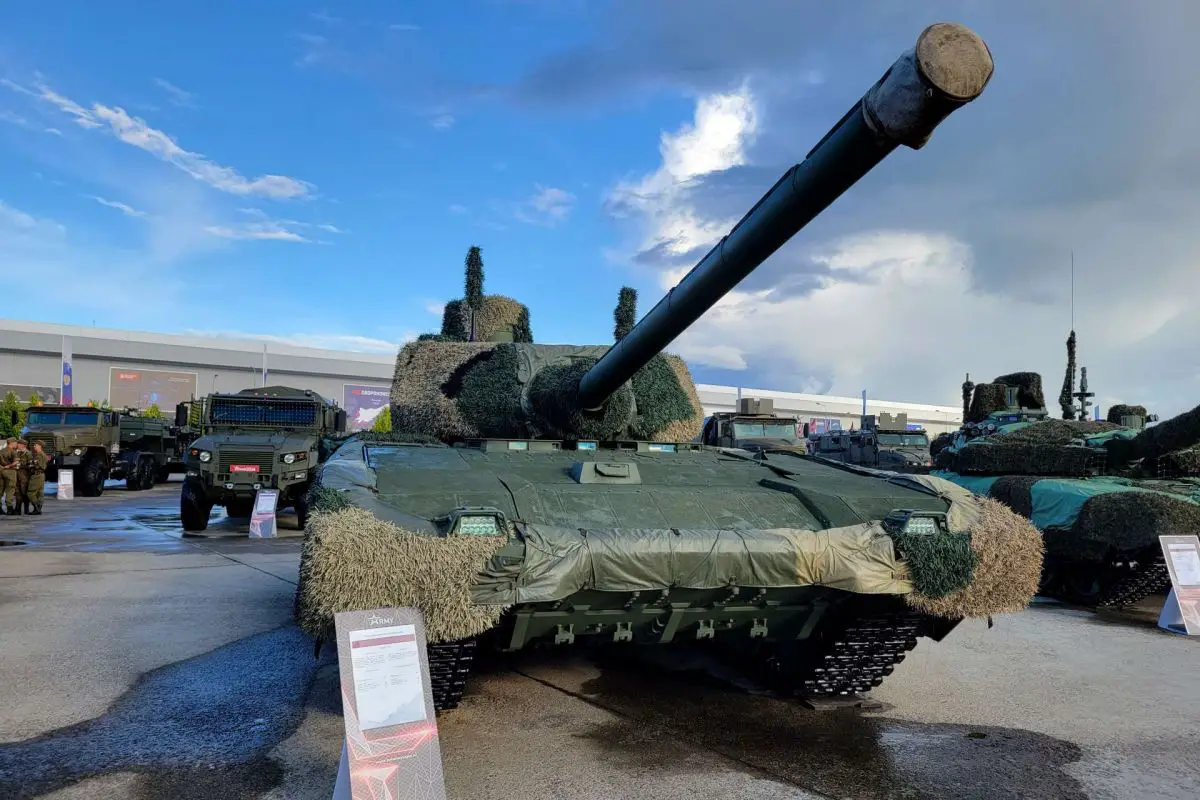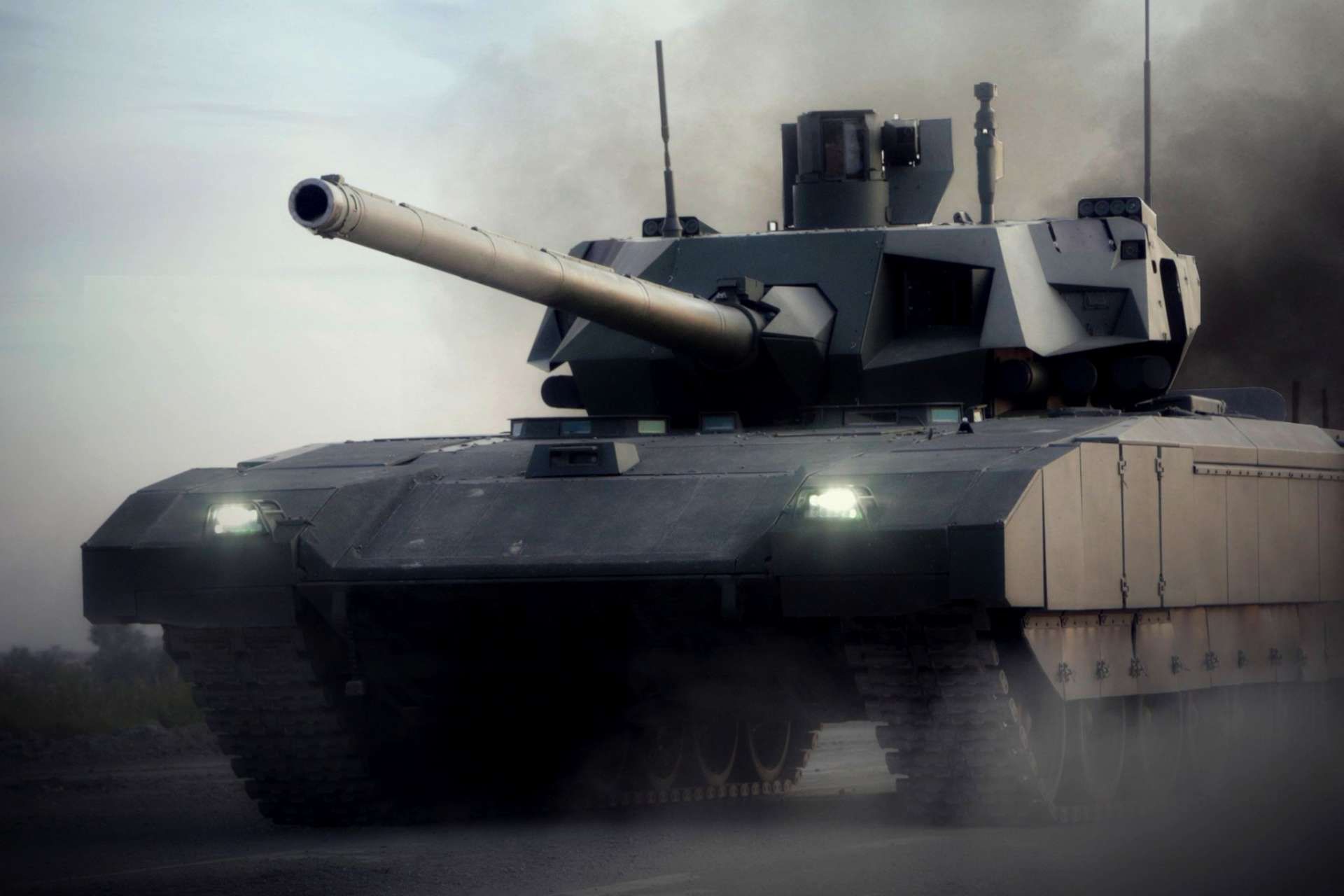Breaking News
Russia displays T-14 Armata tank featuring Nakidka radar-absorbent camouflage.
As reported by Kontakt6 on August 17, 2024, Russia presented a T-14 Armata tank equipped with the Nakidka thermal camouflage system at the Army-2024 event. The Nakidka system, a radar-absorbent material (RAM) camouflage, is intended to reduce the visibility of Russian military assets to various reconnaissance and targeting systems. Developed by the Scientific Research Institute of Steel (NII Stali), this system is designed to decrease the infrared, thermal, and radar signatures of objects.
Follow Army Recognition on Google News at this link

The complete Nakidka camouflage system weighs approximately 125 kg and can be installed within 0.4 to 1.0 man-hours per square meter. (Picture source: Twitter/Kontakt6)
The Nakikda's application extends beyond armored fighting vehicles to include field fortifications, command posts, vehicle sheds, and ammunition and fuel depots. The system does not require specialized equipment for deployment. The Nakidka system is reported to reduce the likelihood of detection significantly, as NII Stali claims that it decreases detection by day/night viewers, TV systems, and seekers by 30 percent. Detection by infrared seekers is reduced by two to three times, and radar detection by six times, with the thermal-radar signature reduced to near-background levels.
The system is effective in the optical, infrared, and radar wavelength bands up to 12 centimeters and lowers the radar cross section by 10 decibels. The Nakidka system is relatively lightweight, with the material itself weighing 2 kilograms per square meter. The complete camouflage system weighs approximately 125 kg and can be installed within 0.4 to 1.0 man-hours per square meter. It is designed to endure combat conditions, including small arms fire and napalm attacks. The system is secured to vehicles using brackets, belts, and buckles, which can be adjusted with standard tools from a tank's toolkit.
However, the presentation of the Nakidka system on the T-14 Armata tank at the Army-2024 event has prompted discussions regarding its practicality. The Nakidka appeared to cover critical turret sensors, radars, and the optics used by the gunner and commander, potentially impairing the tank's active protection system (APS) and laser warning receivers (LWR), according to Kontakt6.

The Nakidka system is secured to vehicles using brackets, belts, and buckles, which can be adjusted with standard tools from a tank's toolkit. (Picture source: Vitaly Kuzmin)
The T-14 Armata, which is Russia's latest main battle tank, includes features such as a remote-controlled 125 mm cannon, advanced sensors, and an active protection system. The tank is powered by a 1,500 horsepower engine, allowing it to reach speeds of up to 90 km/h (56 mph) on roads and traverse rough terrain. The T-14's design includes an armored capsule for its three-man crew, providing safety by enabling remote operation of the cannon. The development of the T-14 has encountered delays, technical challenges, and cost overruns. The tank's estimated cost of $5 million to $9 million per unit is significantly higher than that of Russia's T-72, T-80, and T-90 tanks. This high cost has limited its deployment and raised questions about its utility, particularly in the ongoing conflict in Ukraine.
Reports suggest that the T-14 has undergone testing and is in the final stages of troop trials, but its deployment in Ukraine has been limited. Russian state media reports that the T-14 has been used to fire on Ukrainian positions, but it has not been engaged in direct combat. Analysts have noted potential concerns about the tank's reliability and the logistical challenges it presents in a conflict zone.
On the other hand, the Nakidka system, which entered serial production in June 2023, has already seen combat use. A T-90M tank equipped with Nakidka was captured by Ukrainian forces in Kharkiv Oblast, Ukraine, on September 18, 2022. However, the effectiveness of the Nakidka in real combat conditions has been questioned. In early 2023, a Russian T-90M tank equipped with Nakidka was targeted and disabled by a Javelin missile, demonstrating the system's limitations in actual combat scenarios.

The T-14 Armata, while a symbol of Russian military ambition, has struggled to transition from its prototype form to a widely deployed combat vehicle. (Picture source: Russian social media)


























